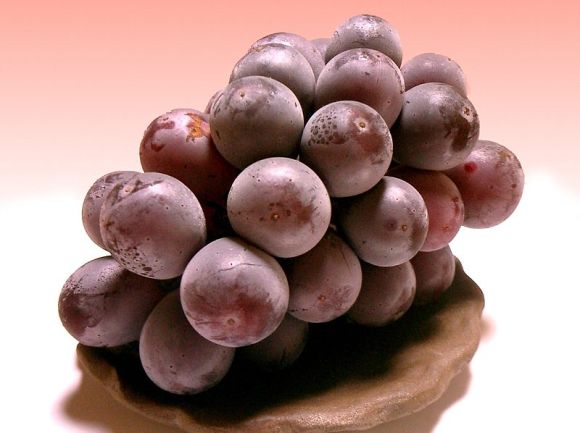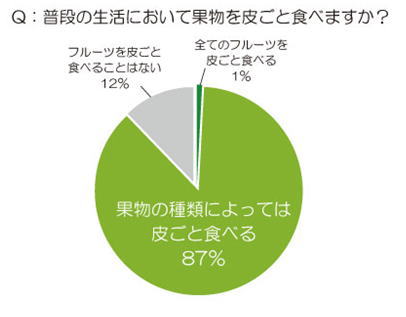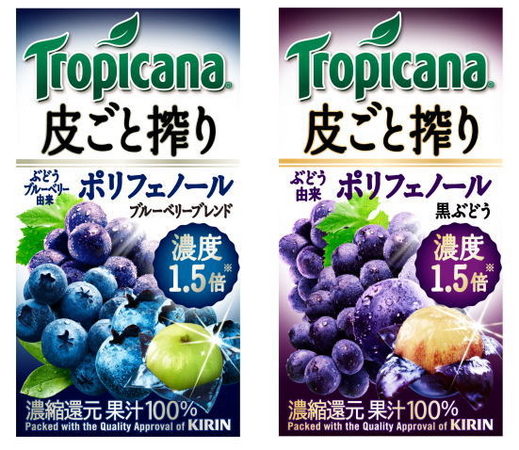
On more than one occasion, when the family would settle down for a nice bowl of grapes, I would do as usual and pop one in my mouth. Almost assuredly my wife’s face would contort into a grimace that would make you think I just licked a dog’s butt. This would soon be followed by a lecture on how the pesticides used on it seep into the skin and cannot be washed off along with pleas to stop this barbaric act.
However, I figured if I haven’t died or gotten so much as a tummy ache thus far, it’s probably okay. Nevertheless, every once and a while my wife would try to slip me a peeled grape to convert me, only to have my face contort into the shape of having licked a dogs butt.
The whole point of all this dog-butt talk is that my wife is not at all alone among Japanese people who refuse to eat the skins of certain fruits. However, in recent years, this trend has been changing according to a survey by Tropicana Japan and Dr. “Fruit” Motohashi.
■ Tropicana Survey
Tropicana surveyed 1,002 women about their fruit habits and among those who regularly ate fruit 87 percent responded that they would eat the peel of certain kinds of fruit. The other 12 percent said that they don’t eat the skin of fruit at all. And then there was one percent who said they eat the skin of all fruits who were clearly lying just to feel special.
That first 87 percent was then asked what fruits they ate the skin of. Blueberries were the highest response with 76 percent of respondents eating the skins, apple came in second with 74 percent, and grape was third with only 69 percent of women not peeling.
Dr. Motohashi believes this is a recent trend in Japan because people are becoming more aware of health issues and discovering that in addition to the flesh of the fruit, the skin is an excellent source of nutrition. He reminds people that eating peeled apples deprives them of antioxidants, potassium, calcium, vitamin C, and dietary fiber. We trust him because he looks really confident.
He goes on to say that while this has only been recently studied in Japan, fruit skin nutrition has been well understood for decades in North America and Europe whose residents tend to eat it more.
■ Our Survey
Although it’s probably a move to better health with more and more Japanese people taking on the habit of eating at least some fruit peels, the numbers of the Tropicana survey still seem particularly high compared to personal experience.
So we at RocketNews24 have conducted our own survey adhering to the strictest of scientific standards and just asked anyone we happened to bump into today. While Tropicana focused solely on women, we asked all genders and age groups.
“I sometimes eat an apple with the skin, but my teeth have gaps and it’s annoying when the peel gets in between. I just don’t like the texture of grape skins.”
(Female, 50s)“I don’t like apple skin because it’s not clean and too hard. Grape skin’s also dirty but has more of a bitter taste.”
(Female, 30s)“I used to never eat grape skins because I was worried about the chemicals. Now, I mostly buy organic and even if I don’t I just take a chance and eat the whole thing. I don’t eat apples much but I always peel pear because the skin isn’t very good.”
(Male, 70s)“I don’t eat apple peels because they just don’t taste very good. I don’t like grape skins because they are too thick. It’s like eating a melon rind.”
(Male, 30s)“I never have eaten the apple’s skin just out of habit and the grape skins are too thick. However, now that I hear it’s healthy I will try to eat apple peels from now on.”
(Male, 40s)“I don’t like grape or apple skins because they’re hard to bite and they taste bitter and sour. I don’t even think of them as part of the fruit.”
(Male, 20s)“Dumbass, eating grape skins is like sucking on the barrel of a loaded gun. Enjoy the poison! Now go take out the garbage and sit next to it. Hopefully they’ll pick you up too this time.”
(My Wife, Undisclosed)
Our answers seemed to almost unanimously land in the “no way” category with only a few lukewarm interests in eating apple or grape skins. No one eats blueberries in our survey aside from yogurt toppings or pastry fillings. Needless to say, we don’t exactly roll in the healthiest of circles.
■ Conclusion
This is a rather large assumption, but if we take both the Tropicana and our survey into account it would seem that health conscious women are getting into eating fruit skins en masse. These women are perhaps the best demographic for Topicana’s new series of juice squeezed with the peel starting with “blueberry blend” and “black grape” which just happened to have been released on 8 April.
On the other hand, it would seem that many of the people on the streets are still weary of a fruit’s outer coating but perhaps open to change. On a more global scale it’s a case of one’s trash is another’s treasure. While many shun apple and grape skins in Japan, fish with its skin attached is readily available and eaten whole. I love bread heels for all their crusty goodness and yet they’re surprisingly hard to find attached to loaves of bread in any supermarket in this country. Go figure.
The world’s full of many different types of people who enjoy many different types of food in many different ways. It’s part of what makes this a wonderfully diverse planet. So, please don’t judge people based on their diets… Unless they’re one of those types who eat light bulbs and billiard balls on TV. I judge them, and they are weird.
Source: PR Times, Tropicana via Entabe (Japanese)
Top Image: Wikipedia – Tomomarusan




 Japanese makers of Tropicana fined 19 million yen for “100% Melon” juice with only 2% melon juice
Japanese makers of Tropicana fined 19 million yen for “100% Melon” juice with only 2% melon juice How to make amazing Japanese fruit flower sandwiches
How to make amazing Japanese fruit flower sandwiches The cool way to peel a mandarin, according to a Japanese grandma
The cool way to peel a mandarin, according to a Japanese grandma 7-Eleven sells grapes with skins you can actually eat! We kid you not
7-Eleven sells grapes with skins you can actually eat! We kid you not Vegetables are smarter than fruits: Three high IQ Japanese veggies
Vegetables are smarter than fruits: Three high IQ Japanese veggies Hayao Miyazaki says Happy New Year to Studio Ghibli fans with new art for Year of the Horse
Hayao Miyazaki says Happy New Year to Studio Ghibli fans with new art for Year of the Horse Pizza Hut Japan’s hot lucky bags are perfect for a New Year’s pizza party
Pizza Hut Japan’s hot lucky bags are perfect for a New Year’s pizza party Check out this 8m robot that appeared on Tokyo’s waterfront【Video】
Check out this 8m robot that appeared on Tokyo’s waterfront【Video】 McDonald’s Japan is changing the ingredients in Chicken McNuggets
McDonald’s Japan is changing the ingredients in Chicken McNuggets Pitch-black Black Belt udon noodles are a visual roundhouse, but do they taste good?【Taste test】
Pitch-black Black Belt udon noodles are a visual roundhouse, but do they taste good?【Taste test】 Harajuku’s new permanent Tamagotchi shop is filled with cuteness and a surprising lack of poop
Harajuku’s new permanent Tamagotchi shop is filled with cuteness and a surprising lack of poop How to speak Japanese like a gyaru【2024 edition】
How to speak Japanese like a gyaru【2024 edition】 Japan abolishes skirts from policewoman uniforms nationwide
Japan abolishes skirts from policewoman uniforms nationwide Princesses, fruits, and blacksmiths: Study reveals the 30 most unusual family names in Japan
Princesses, fruits, and blacksmiths: Study reveals the 30 most unusual family names in Japan Hello Kitty Choco Egg figures are an adorable trip through three periods of Japanese pop culture【Pics】
Hello Kitty Choco Egg figures are an adorable trip through three periods of Japanese pop culture【Pics】 Starbucks Japan ready to get Year of the Horse started with adorable drinkware and plushies【Pics】
Starbucks Japan ready to get Year of the Horse started with adorable drinkware and plushies【Pics】 7-Eleven Japan’s ramen-cooking robot whipped us up a bowl of noodles【Taste test】
7-Eleven Japan’s ramen-cooking robot whipped us up a bowl of noodles【Taste test】 Cyberpunk anime meets traditional culture in Ghost in the Shell gold leaf Japanese changing screens
Cyberpunk anime meets traditional culture in Ghost in the Shell gold leaf Japanese changing screens 7 great places to see Mt. Fuji from without having to climb it
7 great places to see Mt. Fuji from without having to climb it Japan’s otoshidama tradition of giving kids money at New Year’s gets a social welfare upgrade
Japan’s otoshidama tradition of giving kids money at New Year’s gets a social welfare upgrade We found possibly the quietest Japanese-style hotel in Tokyo’s bustling Shinjuku district
We found possibly the quietest Japanese-style hotel in Tokyo’s bustling Shinjuku district Lacquerware supplier to emperor of Japan and Pokémon team up for new tableware
Lacquerware supplier to emperor of Japan and Pokémon team up for new tableware Sumo Sanrio! Hello Kitty and pals team up with Japan Sumo Association for new merch【Pics】
Sumo Sanrio! Hello Kitty and pals team up with Japan Sumo Association for new merch【Pics】 Can a dirty butthole make you filthy rich in Japan? We’re starting a New Year’s lottery experiment
Can a dirty butthole make you filthy rich in Japan? We’re starting a New Year’s lottery experiment 7-Eleven Japan starts new temporary luggage storage service in over 300 branches
7-Eleven Japan starts new temporary luggage storage service in over 300 branches Disillusionment at Tsukiji’s tourist-target prices led us to a great ramen restaurant in Tokyo
Disillusionment at Tsukiji’s tourist-target prices led us to a great ramen restaurant in Tokyo Starbucks teams up with 166-year-old Kyoto doll maker for Year of the Horse decorations【Photos】
Starbucks teams up with 166-year-old Kyoto doll maker for Year of the Horse decorations【Photos】 Tokyo considering law requiring more trash cans following litter increase in heavily touristed area
Tokyo considering law requiring more trash cans following litter increase in heavily touristed area Tokyo’s Tsukiji sushi neighborhood asks tour groups to stay away for the rest of the month
Tokyo’s Tsukiji sushi neighborhood asks tour groups to stay away for the rest of the month Nintendo’s Kirby now delivering orders at Kura Sushi restaurants, but not in Japan
Nintendo’s Kirby now delivering orders at Kura Sushi restaurants, but not in Japan Tokyo event lets you travel back in time, for free, to celebrate 100 years since Showa era start
Tokyo event lets you travel back in time, for free, to celebrate 100 years since Showa era start Sanrio theme park in Japan announces plans to expand into a Sanrio resort
Sanrio theme park in Japan announces plans to expand into a Sanrio resort Japan may add Japanese language proficiency, lifestyle classes to permanent foreign resident requirements
Japan may add Japanese language proficiency, lifestyle classes to permanent foreign resident requirements Survey asks foreign tourists what bothered them in Japan, more than half gave same answer
Survey asks foreign tourists what bothered them in Japan, more than half gave same answer Japan’s human washing machines will go on sale to general public, demos to be held in Tokyo
Japan’s human washing machines will go on sale to general public, demos to be held in Tokyo Japan’s deadliest food claims more victims, but why do people keep eating it for New Year’s?
Japan’s deadliest food claims more victims, but why do people keep eating it for New Year’s? We deeply regret going into this tunnel on our walk in the mountains of Japan
We deeply regret going into this tunnel on our walk in the mountains of Japan Studio Ghibli releases Kodama forest spirits from Princess Mononoke to light up your home
Studio Ghibli releases Kodama forest spirits from Princess Mononoke to light up your home Major Japanese hotel chain says reservations via overseas booking sites may not be valid
Major Japanese hotel chain says reservations via overseas booking sites may not be valid Put sesame oil in your coffee? Japanese maker says it’s the best way to start your day【Taste test】
Put sesame oil in your coffee? Japanese maker says it’s the best way to start your day【Taste test】 No more using real katana for tourism activities, Japan’s National Police Agency says
No more using real katana for tourism activities, Japan’s National Police Agency says Starbucks Japan reveals new sakura drinkware collection, inspired by evening cherry blossoms
Starbucks Japan reveals new sakura drinkware collection, inspired by evening cherry blossoms Updated cherry blossom forecast shows extra-long sakura season for Japan this year
Updated cherry blossom forecast shows extra-long sakura season for Japan this year Our 40-year-old reporter tries muscat grapes for the first time, conquers childhood trauma
Our 40-year-old reporter tries muscat grapes for the first time, conquers childhood trauma Can we pick out the expensive Japanese grapes in a blind taste test?
Can we pick out the expensive Japanese grapes in a blind taste test? Tropicana’s Japanese licensee in hot juice for cartons that boast “100% Melon Taste”
Tropicana’s Japanese licensee in hot juice for cartons that boast “100% Melon Taste” Japanese people reveal the six western foods they find most disgusting
Japanese people reveal the six western foods they find most disgusting This super-rare Japanese banana has edible skin!【Taste test】
This super-rare Japanese banana has edible skin!【Taste test】 Japanese kids becoming less skilled at starting fires, not getting covered with mud, survey shows
Japanese kids becoming less skilled at starting fires, not getting covered with mud, survey shows Kandaba, moui, and sakuna: We have fun taste-testing Okinawan fruits and vegetables
Kandaba, moui, and sakuna: We have fun taste-testing Okinawan fruits and vegetables How I learned to stop worrying and love the Egg’wich in Osaka
How I learned to stop worrying and love the Egg’wich in Osaka Tokyo store sells beautiful Japanese fruit sandwiches that look like floral arrangements
Tokyo store sells beautiful Japanese fruit sandwiches that look like floral arrangements One Piece Devil Fruit Bath Bombs from Lush are on their way and will be offered outside Japan too
One Piece Devil Fruit Bath Bombs from Lush are on their way and will be offered outside Japan too We try a Le Lectier, the highest-quality European pear available in Japan【Taste Test】
We try a Le Lectier, the highest-quality European pear available in Japan【Taste Test】 Can we pick out the expensive Japanese watermelon in a blind taste test?
Can we pick out the expensive Japanese watermelon in a blind taste test? Japan has eggs that smell and taste like yuzu citrus fruit, and they’re amazing!
Japan has eggs that smell and taste like yuzu citrus fruit, and they’re amazing! Mandarin orange peels aren’t trash, they’re treasure! Three chimpi tips to reuse your mikan skins
Mandarin orange peels aren’t trash, they’re treasure! Three chimpi tips to reuse your mikan skins Japan has $10 bananas from the coldest prefecture in the country, but how do they taste?
Japan has $10 bananas from the coldest prefecture in the country, but how do they taste? One Piece devil fruit ice cream coming back to Baskin-Robbins Japan
One Piece devil fruit ice cream coming back to Baskin-Robbins Japan
Leave a Reply